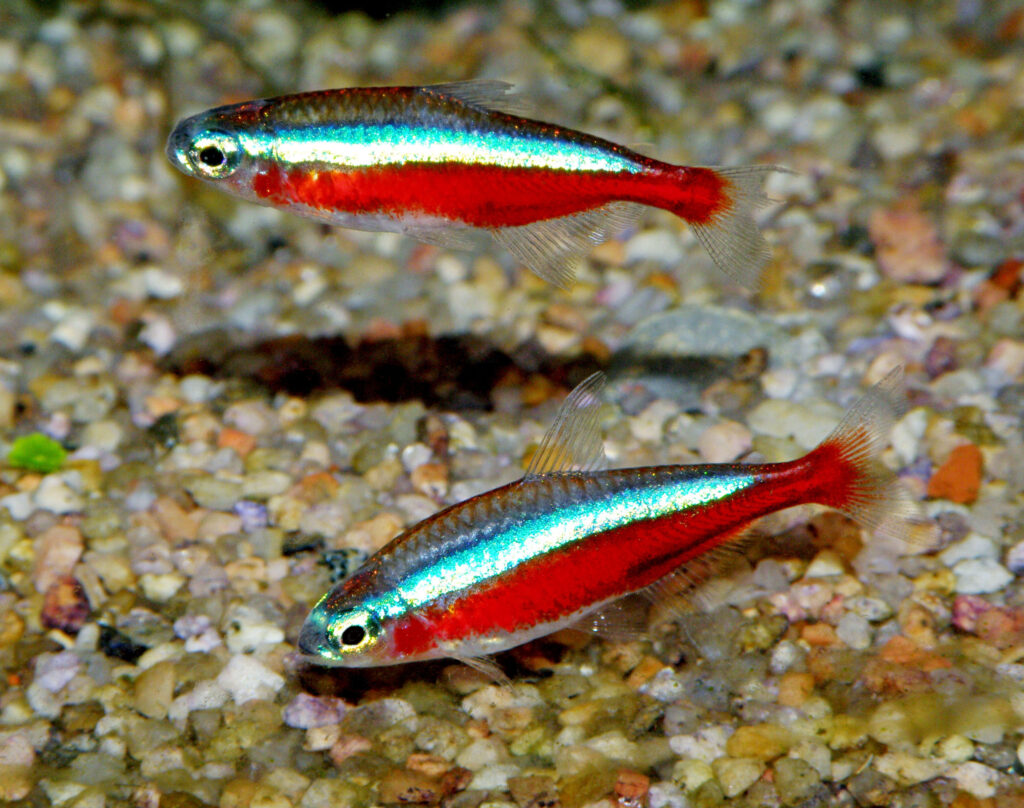Learn everything about cardinal tetra care, including tank setup, diet, lifespan, size, and tank mates. This complete guide helps you keep your tetras healthy, vibrant, and happy.
If you’ve ever stared at an aquarium and been mesmerized by tiny streaks of neon blue and red flashing across the water, chances are you were looking at Cardinal Tetras. These small but stunning fish are like living jewels. When I first added them to my community tank, I couldn’t believe how much life and color they brought into the room.
👉 Quick Answer: Cardinal Tetra care means keeping them in groups of 6+, providing a warm, well-planted tank, offering a varied diet, and maintaining stable, clean water.
Cardinal Tetra Size & Max Size
👉 Short Answer: Cardinal Tetras reach about 2 inches in size, with a max size of around 2.5 inches in captivity.
They’re tiny, but don’t underestimate their impact. Their bold colors make them stand out even in large aquariums. I’ve had people walk into my living room and ignore my bigger cichlids, asking instead, “What are those little glowing ones?”
💡 Tip: Their small size makes them perfect for nano tanks, but they truly shine in schools of 10 or more in medium-sized aquariums.
Cardinal Tetra Lifespan
👉 Short Answer: With good care, Cardinal Tetras live 4–6 years, though some aquarists report up to 8 years.
When I first kept them, I was shocked by how delicate they seemed at first, but once settled, they proved surprisingly hardy. Clean water and a stress-free environment are the keys to unlocking their full lifespan.
Cardinal Tetra Tank Setup
👉 Short Answer: Cardinal Tetras thrive in planted aquariums with soft, slightly acidic water and gentle filtration.
Here’s what works best for them:
-
Tank Size: 20 gallons minimum (bigger is better for larger schools).
-
Plants: Amazon swords, Java fern, and floating plants for shade.
-
Substrate: Dark sand or fine gravel to make their colors pop.
-
Water Parameters: 74–82°F, pH 5.0–7.0, soft water preferred.
-
Filtration: Sponge or gentle filter to avoid strong currents.
When I upgraded my group to a 40-gallon planted tank, they transformed—swimming more confidently and showing off brighter colors than ever.
💡 Pro Tip: I use the Fluval Plant 3.0 LED Light to highlight their colors. The reds and blues almost glow under the right lighting.
Cardinal Tetra Diet
👉 Short Answer: Cardinal Tetras need a varied diet of flakes, micro-pellets, and frozen/live foods.
They’re small, so food size matters. Here’s a reliable mix:
-
Staple Food: Tetra Tropical Flakes – easy for them to eat.
-
Micro Pellets: Hikari Micro Pellets – nutrient-rich and bite-sized.
-
Frozen & Live Foods: Baby brine shrimp, daphnia, bloodworms (in moderation).
My tetras go absolutely crazy for frozen baby brine shrimp. Feeding time becomes a cloud of flashing colors as they dart around like fireworks in the water.
Cardinal Tetra Tank Mates
👉 Short Answer: Cardinal Tetras do best with peaceful, non-aggressive tank mates of similar size.
Good tank mates include:
-
Neon Tetras
-
Corydoras Catfish
-
Harlequin Rasboras
-
Small peaceful Gouramis
-
Otocinclus Catfish
Avoid: Large cichlids, bettas, or fin-nippers like Tiger Barbs.
💡 From experience: I once mistakenly put Cardinals with a Betta. Let’s just say it wasn’t a good mix—the Betta saw them as competition and kept chasing them.
Cardinal Tetra Behavior & Personality
👉 Short Answer: Cardinal Tetras are schooling fish that feel safest and happiest in groups of 6+, ideally 10–15.
Their behavior is soothing to watch—they move in perfect synchrony, flashing their neon colors like a living ribbon in the water. When kept alone or in too-small groups, they can become stressed and hide all the time.
The first time I bumped my group up to 12, the difference was night and day—they went from hiding in corners to swimming proudly across the tank.
Breeding Cardinal Tetras
👉 Short Answer: Breeding Cardinals is possible but challenging because they require very soft, acidic water.
Tips for breeding:
-
Use a separate dimly lit breeding tank.
-
Provide fine-leaved plants or a spawning mop.
-
Condition with live foods.
-
Remove adults after spawning (they’ll eat the eggs).
I’ve only had limited success myself, but advanced hobbyists with soft water setups often manage to raise fry.
Common Health Issues
👉 Short Answer: Cardinal Tetras are hardy once settled, but they can suffer from Ich, fin rot, and stress-related diseases.
Prevention tips:
-
Always quarantine new fish.
-
Keep water parameters stable.
-
Avoid overcrowding.
-
Maintain a balanced diet.
I once lost half my school to Ich after rushing a new fish introduction. Since then, I always quarantine for at least two weeks before adding new fish.
Cardinal Tetra Lifespan: How to Extend It
👉 Short Answer: Stable water, low stress, and a good diet are the secrets to long-living Cardinals.
Think of them like houseplants—you can’t just toss them in and hope for the best. With a little consistent care, they reward you with years of beauty and activity.
Tips for Success with Cardinal Tetra Care
-
Keep Schools of 6+ (ideally 10–15).
-
Choose Gentle Tank Mates Only.
-
Provide a Planted, Dimly Lit Tank.
-
Feed a Variety of Foods.
-
Keep Water Clean and Stable.
When I follow these steps, my Cardinals thrive. When I cut corners, they get stressed and dull. They really do show you what they need if you pay attention.
Final Thoughts on Cardinal Tetra Care
Cardinal Tetras may be small, but they bring an outsized presence to any aquarium.
👉 Quick Recap:
-
Size: 2 inches, max 2.5.
-
Lifespan: 4–6 years (up to 8).
-
Tank Setup: 20+ gallons, planted, soft water.
-
Diet: Flakes, micro-pellets, live/frozen food.
-
Tank Mates: Peaceful, small fish.
If you’re looking for a fish that combines beauty, personality, and peacefulness, Cardinal Tetras are a near-perfect choice. They’ll light up your tank—and your living room—for years to come.

